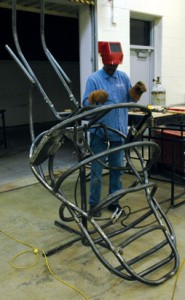By André Green/se news editor

Thunderous applause accompanied by a standing ovation usually concludes the performances at the C.A. Roberson Theatre.
But often overlooked is the hard work done behind the scenes by students of the SE Campus drama department.
The planning
Alex Robertson, technical director, and his team have worked almost non-stop for the past eight weeks to ensure Little Shop of Horrors goes off without a hitch this week. Although the physical work began weeks prior to spring break, the actual planning has been in effect for months.
“ We had our official meeting at the beginning of the semester,” he said. “The concept model of the stage and the first model of Audrey II were done around the second week of classes.”
Robertson said while working on Balcony Scene, they began fabrication on Little Shop of Horrors.
“ It is a big production,” he said.
The props

The amount of time spent on designing and building the set and props can be attributed to Robertson’s dedication to making the SE production of Little Shop something audience members will remember.
The stage and four puppets may not seem like much to some, but when the stage has to revolve and one of the puppets is a man-eating, mean green mother from outer space, that adds a certain degree of difficulty and frustration to the project.
“ None of us has any formal training in puppet making,” he said. “That makes it difficult to say ‘here is my goal’ and reaching it. There is no kit you can buy and put it together.”
Robertson said Audrey II’s concept came from looking at the best and worst designs from other models and making something in between. He wanted his design to be unique and memorable.
“ Most of the other designs just have the top jaw that operates and a slide for the actors to go down [when eaten],” he said. “I wanted to be able to pick the person up off the ground.”
The stage
The revolving stage concept, Robertson said, was necessary because of the size of the current stage. The activity and scene changes throughout the performance required more space.
The stage depth combined with the continuously changing scene location would increase the work dramatically without an accommodating stage. Robertson’s concept is meant to draw the audience into the play and let them experience every element of the production.
“ I wanted to have all musical numbers downstage to be seen and heard by everybody,” he said.




























